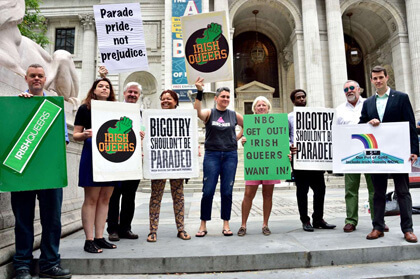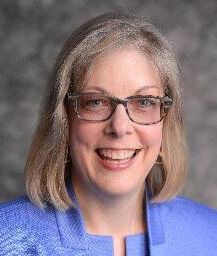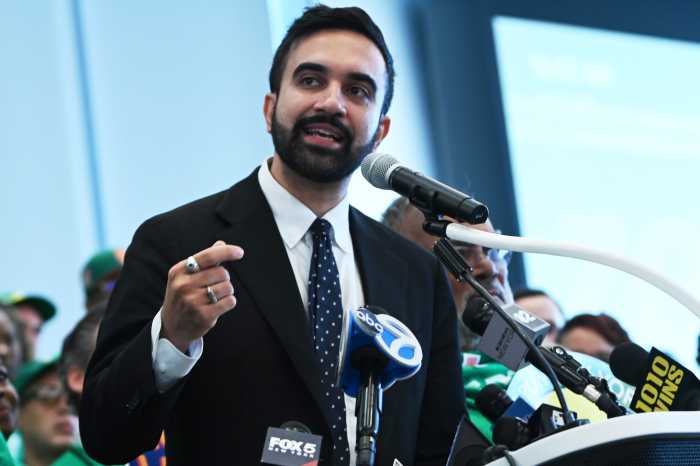MAGINATION BOOKS
June is the season of the rainbow, and now there’s a new book helpichildren better understand how this symbol became part of the LGBTQ civil rights movement. “Sewing the Rainbow,” written by Gayle Pitman, PhD, and illustrated by Holly Clifton-Brown, honors iconic Rainbow Flag creator Gilbert Baker who died early last year. The book takes readers from Gilbert’s Kansas childhood through his time in the army to his career as an artist and activist in San Francisco.
Pitman is a professor of psychology and women’s studies at Sacramento City College. Her teaching and writing focus on gender and sexual orientation. Among other books, she is author of “This Day In June” (Magination Press, 2014), winner of the 2015 Stonewall Book Award. Gay City News spoke to Pitman about her newest book.
Gayle Pitman, Holly Clifton-Brown bring Gilbert Baker’s story to children
MICAHEL LUONGO: What inspired you to create this book?
GAYLE PITMAN: The inspiration for “Sewing The Rainbow” wasn’t so much a “what,” but more of a “who.” My friend Laurie McBride is a longtime LGBTQ+ activist in Sacramento. She knew lots of people active in the gay rights movement in the 1970s and 1980s, including Cleve Jones — the founder of the NAMES Project and the AIDS Quilt — and Gilbert Baker. After reading “This Day In June,” Laurie said to me, “Somebody needs to write a book about Gilbert.” That’s when the light bulb went on for me. Shortly afterwards, Laurie and I met, and she shared all sorts of stories with me about Gilbert. I really give Laurie all the credit for painting a picture of Gilbert’s creative and campy personality. He had a biting and edgy sense of humor, but he was also incredibly loving and generous.
ML: Did you know Gilbert personally?
GP: I’d met Gilbert years before I even considered writing this book, but it was a brief introduction. Gilbert died merely weeks before Laurie’s comment to me, so I never had the opportunity to interview him personally. Thankfully, Gilbert had done numerous print, TV, and documentary interviews over the years. Also, Gilbert’s many surviving friends have been very generous with their time, and their personal anecdotes have given me a very rich sense of who Gilbert was.
ML: Rainbows are natural for kids’ books, but they have a new meaning with the LGBTQ movement. Can you comment on that contrast or happy coincidence?
GP: I don’t think it’s a happy coincidence at all, actually. Rainbows have been a part of the LGBTQ+ movement for decades, and I credit Judy Garland and “The Wizard of Oz” for that. Back in the 1950s and 1960s, Judy Garland was an icon in the gay community, and many gay men deeply connected with the song “Somewhere Over the Rainbow.” Judy died just days before the Stonewall riots took place, and some historians believe that the gay community’s angst over her accidental overdose added to the tension before the riots erupted. Gilbert himself was from Kansas, and the symbolism of the rainbow certainly wasn’t lost on him. He, like many gay men, dreamed of living a beautiful life “somewhere over the rainbow,” and the rainbow flag reflects that.
Gilbert Baker, smiling as he sews one of innumerable Rainbow Flags he stitched together for the world’s LGBTQ community. | COURTESY OF GILBERT BAKER ESTATE
ML: How long did it take you to put this book together, from concept to research to the illustrations and what to include and not include?
GP: From start to finish, the book took about a little over a year to move from its idea stage in April 2017 to a completed manuscript to publication. The book was fast-tracked so it would coincide with the 40th anniversary of the Rainbow Flag. What to include or not is also complicated, as writing children’s books is incredibly challenging. For starters, you have limited real estate. Publishers typically want authors to keep the word count below 1,000 words — and increasingly, publishers are aiming for 500 or 600 words. So authors have to make every word count. Also, when I write for children, I try to put myself into the mindset of a young child, rather than writing from an adult perspective. Nitty-gritty details often don’t interest young children, but they do hold interest for the adults who are reading to them. Picture books for children lend themselves well to conversations and questions. Because picture books are interactive by design, parents and other adults can use the Note to Readers at the back of the book to fill in details if they feel like their child would be interested in them.
ML: Were there any surprises for you in creating the book?
GP: I was surprised how much of a footprint Gilbert has had on the LGBTQ+ community. Personally, I loved learning about the many costumes Gilbert created for people like José Sarria and other members of the Imperial Court, as well as for performers like Sylvester. Gilbert also created banners for protest marches throughout the 1970s.
ML: Who is the market for the book — any particular age group? Similarly, what do you hope adults get from the book?
GP: Technically, “Sewing the Rainbow” is for children between the ages of four and eight. However, I think people of any age can enjoy it and benefit from it. Even today, most schools don’t teach LGBTQ+ history, and as a result, those of us in the LGBTQ+ community are often disconnected from our historical and cultural roots. Books like “Sewing the Rainbow” can help fill in those informational gaps.
SEWING THE RAINBOW: THE STORY ABOUT GILBERT BAKER AND THE RAINBOW FLAG | By Gayle Pitman, PhD | Illustrated by Holly Clifton-Brown | Magination Press |$16.95; 32 pages




































